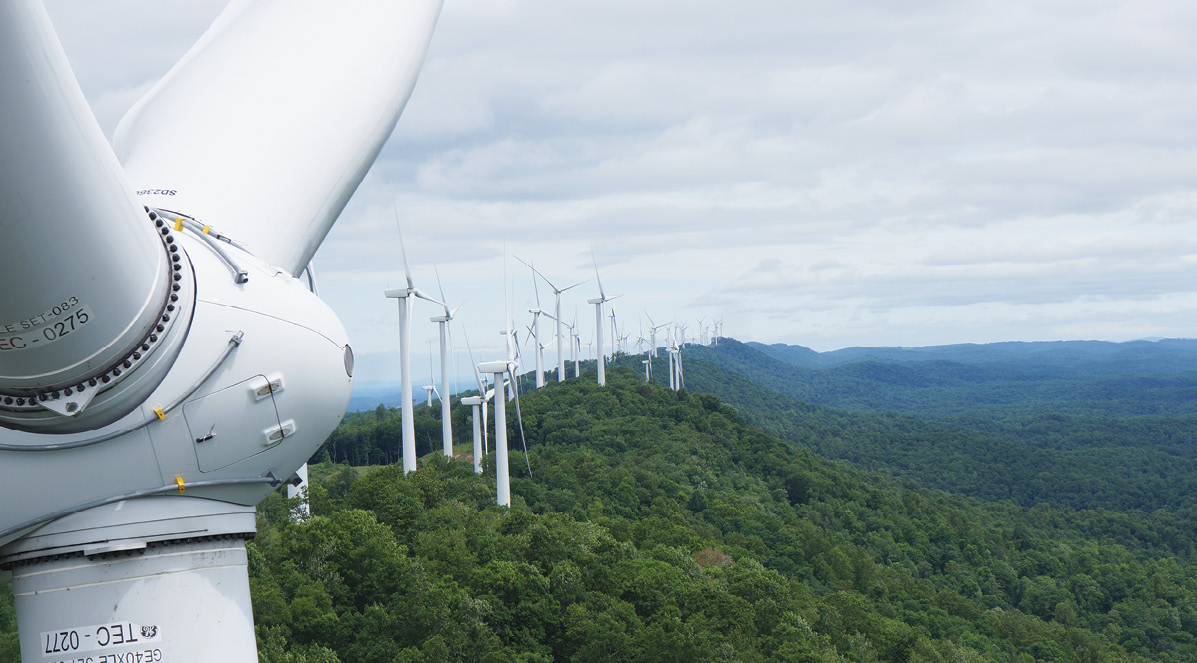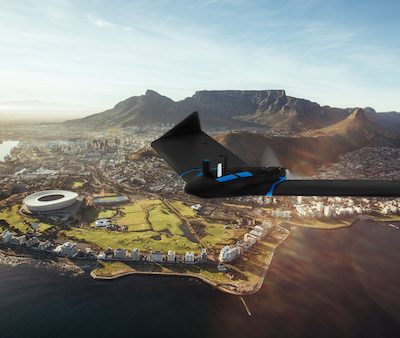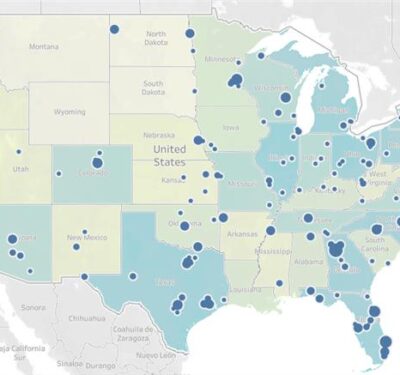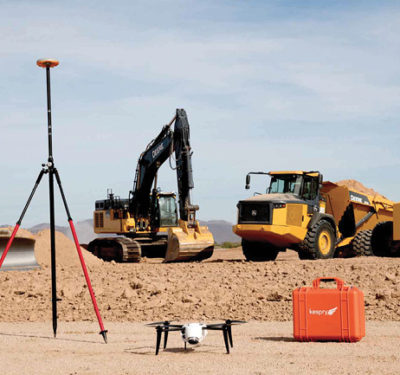
ING Robotic Aviation
The first year AES Wind Generation’s Buffalo Gap Wind Farm deployed unmanned aerial systems to inspect its turbines, the team found about $1 million worth of blade damage that needed repair.
That was in 2014, and over the last two years the farm has continued to work with AAIR, the company that operated the UAS, to make wind turbine inspections more cost effective and safer.
“Finding that amount of damage was pretty significant,” farm site planner Justin Calcote said, noting most of it was caused by lightning strikes. “Before drones we relied on technicians to spot damage from the ground, but the blades are pretty high up there. Some damage could be as small as 3 or 4 inches in length and half an inch in diameter. That’s really difficult to see from the ground. With a drone, there’s a 25 megapixel camera 10 feet away from the blade taking high-quality photos.”
The team at Buffalo Gap only planned to inspect a small percentage of its 295 turbines that first year, Calcote said, but because the initial inspections identified a lot of lightning damage at one of their three Texas sites, they decided to inspect every turbine there. The goal each year is to inspect two thirds of the turbines at every site, a task UAS makes much easier to achieve.
Like Buffalo Gap, many other wind farms across the globe are turning to UAS to perform these critical inspections. As of early 2015, there were about 270,000 wind turbines operating in the world, according to Navigant Research, with a total of more than 800,000 blades that need assessment. With cumulative global revenue for wind turbine UAS sales and inspection services expected to reach close to $6 billion by 2024, there’s a lot of potential work for UAS.
“Wind turbine and blade inspection seems to be the area most apt to capitalize from this type of technology,” AAIR Vice President and General Manager Grant Leaverton said. “It’s also a component that was somewhat neglected until recently. Historically, owners were heavily focused on drive train equipment, gearboxes and bearings and weren’t too concerned with the blades. As the countrywide fleet ages, they’re starting to realize the blades are the most critical components. The rise of drone technology coupled with the overall aging of the equipment converged into the perfect storm.”
Traditional Inspections
Before drones, there were typically two ways to complete wind turbine inspections—by climbing the tower and rappelling down each blade to capture images or by taking still photos from the ground, Leaverton said.
Rappelling is both dangerous and time consuming—it takes a half day to a day to inspect a turbine this way, something a drone can complete in about 45 minutes—while the ground-based photos just don’t provide the level of detail needed to detect various analomies, said Kevan Rusk, director of the University of North Dakota Technology Accelerator. UND is working with various companies, including EdgeData and LM Wind Power, to study how to automate wind turbine inspections using drones. Rusk worked at LM Wind Power for several years and estimates deploying UAS for these inspections increases the amount of throughput by at least 10 times, even more once the companies get into a rhythm.
It also takes about an hour and a half to inspect one turbine from the ground, said Russel Peck, director of Worldwide Inspection Services for Strat Aero, a company that recently worked with Westar Energy to perform turbine inspections with the DJI Inspire. Moreover, the turbine blades must be moved in various directions so the ground photographers can get the images they need, which tends to be hard on the turbine’s mechanics.
The turbines can’t run during these inspections, and shutting them down costs the farms money, said Ian Glenn, CEO of ING Robotic Innovation. The UAS manufacturer completed wind turbine inspections at Capstone Infrastructure in Canada last year and plans to go back this summer. They found the quicker inspections drones provide lead to much less downtime.
“Every moment those blades aren’t turning, it costs the company money,” Glenn said. “What we did with Capstone showed we could do the inspections much safer and faster, and produce data that’s at least as good as what they get otherwise. In the end, we proved
using UAS for these inspections is at least three times faster, 50 percent cheaper and results in two thirds less down time for the turbines.”

ING Robotic Aviation
What They’re Looking For
After a wind turbine inspection, owners want to determine what repairs need to be made, Leaverton said. They want to know the current health of the fiber glass blades and what damages have occurred over time. They’re looking for lightning damage, cracks, missing chunks, leading edge erosion and any other anomalies that might impact performance.
Blades develop leading edge erosion from sand and dirt and the fact they’re spinning 200 miles an hour for long periods of time, Peck said. That erosion hampers the blade’s aerodynamics, affecting the capability of the blade to turn and generate electricity; ultimately the wear and tear could lead to structural issues.
“It’s all about the efficiency of the turbine,” Glenn said. “Over time, damage occurs and the blades don’t perform at peak ability. Every drop in performance translates into a drop in dollars. Maintenance helps ensure owners get optimal performance out of each turbine. They can see if something is broken off or why turbine 23 isn’t performing the way it did last year.”
Even small cracks, if not addressed, eventually could be fatal for a blade, Peck said. UAS make it possible for owners to find analomies they normally wouldn’t be able to see and to fix problems while they’re still manageable.
“You have to keep blades healthy. You have to repair them and this is a good way to look at those blades,” Peck said. “If a blade were to break in high winds, it could take down the whole turbine—which is a $2 million replacement.”
Managing the Data
One of the biggest challenges facing UAS manufacturers and wind farm owners is managing and interpreting the data that’s collected, said Chris Shroyer, president of EdgeData. During an inspection a drone typically takes 1,600 photos of each turbine—and looking through all those photos can be time consuming, even overwhelming.
Through the partnership with UND and other companies, EdgeData is working to develop a software platform and process to help owners manage the data and integrate UAS inspection into their operations and maintenance program, Shroyer said.
“Management of the data and the information is critical,” he said. “We need to understand what images they need, how to capture those images and to make sure we’re delivering data that’s valuable. The drone takes a picture every four seconds and then stitches those images into a single image of each blade. Users can zoom in on the blade and look for specific areas of damage and highlight areas that might need repair. That’s much easier than flipping through a slideshow. That’s where we started, and is part of the service we still provide, but the real value is in using these images long term.”
The long term for these inspections can span years. When Peck and his team perform wind turbine inspections, they identify each turbine by latitude and longitude and take down the serial number from each blade. That information is used to compare the new images with
images from past and future flights. They also have software that measures the size of an anomaly, which isn’t apparent in a close-up picture.
Strat Aero and AAIR also provide data management. Strat Aero offers customers a customizable data management system, where they have access to any turbine that’s been inspected any time they need it, Peck said. They also provide a report that evaluates the photos and makes it easier for owners to decide which repairs to make.
AAIR recently developed a cloud-based asset portal that organizes and streamlines critical information for wind turbine owners, Leaverton said. These electronic records are searchable and more actionable for owners.
“Data management is where we’ve seen the biggest struggles with our asset owners,” said Leaverton, who uses the Falcon 8 from
Ascending Technologies for these inspections. “You need a good data management strategy no matter who is doing the inspection. If you don’t have that piece of the puzzle in place you might not get the most out of the inspection.”

The Falcon 8 performing the transmission inspection for Buffalo Gap Wind Farm. Buffalo Gap Wind Farm
Other Challenges
While actually flying the UAS is typically pretty smooth, there are other challenges operators and wind turbine owners need to consider. One of those is battery life, Peck said. Batteries typically need to be changed after 20 minutes, even sooner if you’re operating in cold weather and can’t keep the battery properly heated.
“Battery management is an art that we’re still working on perfecting,” Peck said. “You need to have enough batteries to be able to continuously fly. Right now that’s eight batteries per UAV with chargers. You also have to deal with wind. The maximum wind for the vehicle we’re flying is about 22 knots. And of course the wind on the ground is lighter than the wind up in the air at 250 feet.”
Geotagging, determining naming conventions and properly stitching the images proved difficult for the team at the University of North Dakota at first, Rusk said, which goes back to finding ways to processing the data collected.
“The drones are taking 1,000 high definition photos within a half an hour of whitish grey pieces of fiber glass without many visual markings on them,” Rusk said. “We needed a system to set up the order of the imagery and stitch them together correctly so we didn’t have an image from the middle of the blade intermixed with an image of the tip.”
The Future
Until recently, many wind turbine owners didn’t perform inspections as often as they should, mainly because it cost too much and took too much time. UAS offers a quicker, safer and more cost effective alternative, so wind farm owners can more easily get the information they need instead of skipping regular equipment assessments and hoping no damage has occurred.
And the process for setting up drone-based inspections will hopefully get easier once the Federal Aviation Administration releases its regulations for small UAS. While the unsettled regulatory climate creates hurdles, Rusk said, the fact wind turbines are in rural areas away from congestion and airports makes it easier to fly UAS for this type of inspection. As the technology, image processing expertise and data management capabilities improve many see using UAS becoming the standard for this type of work. Eventually the data processing algorithms will enable the system to tell owners the difference between an actual crack and a non-damage anomaly, saving them even more time and money.
Wind farms like the ones Calcote works for will continue to look to UAS for these inspections, not only making it easier for them to collect the data they require but to also run reports and determine which repairs to prioritize. It’s been a pretty smooth process for Calcote and his team, and eventually they’d like to get to a place where they’re performing spot inspections on their own. This will help them get even more out of this technology and ensure their blades are working as they should be.
“Our plan is to keep doing these inspections at least once a year with AAIR,” Calcote said. “It’s definitely the quickest, most efficient and cost effective way to have our blades inspected and to get a good health assessment on them each year.”






